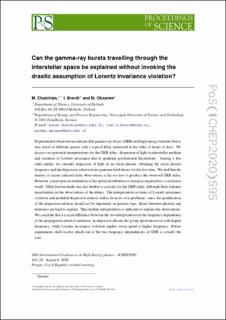| dc.contributor.author | Chaichian, Masud | |
| dc.contributor.author | Brevik, Iver Håkon | |
| dc.contributor.author | Oksanen, Markku | |
| dc.date.accessioned | 2022-09-19T14:20:01Z | |
| dc.date.available | 2022-09-19T14:20:01Z | |
| dc.date.created | 2021-02-05T15:01:04Z | |
| dc.date.issued | 2021 | |
| dc.identifier.citation | Proceedings of Science (PoS). 2021, 390 . | en_US |
| dc.identifier.issn | 1824-8039 | |
| dc.identifier.uri | https://hdl.handle.net/11250/3018985 | |
| dc.description.abstract | Experimental observations indicate that gamma-ray bursts (GRB) and high-energy neutrino bursts may travel at different speeds with a typical delay measured at the order of hours or days. We discuss two potential interpretations for the GRB delay: dispersion of light in interstellar medium and violation of Lorentz invariance due to quantum gravitational fluctuations. Among a few other media, we consider dispersion of light in an axion plasma, obtaining the axion plasma frequency and the dispersion relation from quantum field theory for the first time. We find that the density of axions inferred from observations is far too low to produce the observed GRB delay. However, a more precise estimation of the spatial distribution of axions is required for a conclusive result. Other known media are also unable to account for the GRB delay, although there remains uncertainties in the observations of the delays. The interpretation in terms of Lorentz invariance violation and modified dispersion relation suffers from its own problems: since the modification of the dispersion relation should not be dependent on particle type, delays between photons and neutrinos are hard to explain. Thus neither interpretation is sufficient to explain the observations. We conclude that a crucial difference between the two interpretations is the frequency dependence of the propagation speed of radiation: in dispersive plasma the group speed increases with higher frequency, while Lorentz invariance violation implies lower speed at higher frequency. Future experiments shall resolve which one of the two frequency dependencies of GRB is actually the case. | en_US |
| dc.language.iso | eng | en_US |
| dc.publisher | Sissa Medialab | en_US |
| dc.relation.uri | arXiv:2101.05758 [astro-ph.HE] | |
| dc.rights | Attribution-NonCommercial-NoDerivatives 4.0 Internasjonal | * |
| dc.rights.uri | http://creativecommons.org/licenses/by-nc-nd/4.0/deed.no | * |
| dc.title | Can the gamma-ray bursts travelling through the interstellar space be explained without invoking the drastic assumption of Lorentz invariance violation? | en_US |
| dc.title.alternative | Can the gamma-ray bursts travelling through the interstellar space be explained without invoking the drastic assumption of Lorentz invariance violation? | en_US |
| dc.type | Peer reviewed | en_US |
| dc.type | Journal article | en_US |
| dc.description.version | publishedVersion | en_US |
| dc.source.pagenumber | 6 | en_US |
| dc.source.volume | 390 | en_US |
| dc.source.journal | Proceedings of Science (PoS) | en_US |
| dc.identifier.doi | 10.22323/1.390.0595 | |
| dc.identifier.cristin | 1887161 | |
| cristin.ispublished | true | |
| cristin.fulltext | original | |
| cristin.qualitycode | 1 | |

